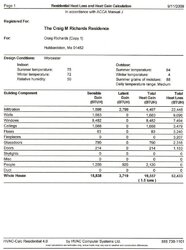I'm going to be in the process of digging up my existing dual insulated 1" pex and adding another dual 1" line. Heaterman was helping me out but hasn't been on the site for a little while (assume he's busy working). My lines will meet at the OWB as well as inside my house. I need to connect the lines via a homemade T of preferable manifold meant for this application. Can someone recommend where to find such a manifold? Also, I will be tying into the existing single 1" copper supply/return (60') line once inside the house, which connects to my 50 plate HX. Will this "kill" what I"m trying to accomplish with the dual supply and return by funneling down to a single line again?
My problem last season was the boiler puts out 120k BTU, my heat load is 53k plus DHW. I heated my home last season without any problems excepet for the extremely high head in the system which caused the pump to cavitate. Any xtra help, thoughts, input will help. Thank you.
My problem last season was the boiler puts out 120k BTU, my heat load is 53k plus DHW. I heated my home last season without any problems excepet for the extremely high head in the system which caused the pump to cavitate. Any xtra help, thoughts, input will help. Thank you.


 I'll try to get back up to speed on this and get back with you.
I'll try to get back up to speed on this and get back with you. 